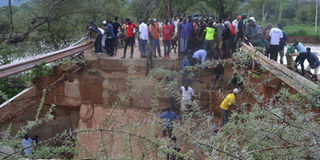Heavy rains normal, says Met as regions set to receive more

Travellers and motorists are stranded at Kainuk bridge in Turkana County on November 6, 2017 after it was damaged by flood water. Relief agencies mainly use the road, which is a gateway to South Sudan. PHOTO | PETER WARUTUMO
What you need to know:
- Residents of flood- and landslide-prone areas in North Rift have been put on high alert.
- The floods have also hampered distribution of relief supplies due to impassable roads.
The heavy rains in most parts of the country are not abnormal.
The deputy director of Kenya Meteorological Department, Mr Samwel Mwangi, on Tuesday said the rains, though intense, were normal during the short rains season, even as he warned of more rainfall.
“Rainfall is expected to continue over most parts of the country for much of the week, with the Coastal region and the northeast expected to continue receiving enhanced rains but not as heavy as those experienced during the March to May season,” Mr Mwangi said.
COLD
An increase in flash floods and poor visibility is possible, he added, and warned motorists to be careful on the road.
The Met also warned of rough oceans along the coastline as well as cold spells.
“The temperatures will be cool, but not very cold as in June and July, due to the heavy cloudiness and shielding of the sun during this period, especially in central parts of the country,” he said.
LANDSLIDES
Meanwhile, residents of flood- and landslide-prone areas in North Rift have been put on high alert.
Geologists urged those living in areas such as Kabasis and Timboiywo and Embobut in Baringo and Elgeyo-Marakwet counties, respectively, to be cautious.
“We call on residents in those areas to move to safety whenever they notice landslide signs such as cracks or water springs near their homes to avert disasters,” Mr Enock Kipseba, a senior geologist, said.
He said population pressure had forced cultivation in steep areas, contributing to increased landslides.
“Our statistics show 80 per cent of the areas affected by landslides are bare and lack vegetation or there are no soil conservation measures in place,” Mr Kipseba said.
LAKE BARINGO
Besides Baringo Central Sub-County, he said, other areas prone to the natural phenomenon include Kasisit village in Baringo North Sub-County and Cheberen in Eldama Ravine.
The volume of water in Lake Baringo is also increasing at an alarming rate.
Nearby primary schools at risk of submersion include Kokwo, Ng’ambo, Sintaan, Loropil, Salabani, Leswo and Ilng’arua in Baringo South Sub-County.
In similar danger are Ng’ambo Day, Salabani and Kiserian Secondary Schools.
Residents told the Nation they were ready to move to safer grounds.
“The situation is very bad. We fear that, should the heavy downpour persist in the next one week, people living in Kokwo Island will have to be relocated back to the mainland as the island is on the verge of being swallowed up,” village elder Losokul Lepario said.
ROADS
The floods have also hampered distribution of relief supplies due to impassable roads with thousands of families facing starvation after exhausting their food stocks.
The agencies cannot access areas hit by famine in Turkana, West Pokot, Baringo and Elgeyo-Marakwet counties.
“Trucks carrying food and other basic commodities are finding it difficult to access families in need of the supplies due to the dilapidated state of the roads,” Sub-County Commissioner Eric Wanyonyi said.
RELIEF FOOD
Kainuk Bridge, which links West Pokot and Turkana, was on Sunday washed away by floods.
Relief agencies mainly use the road, which is a gateway to South Sudan.
“The pathetic state of roads is also hampering security operations, especially in banditry-prone areas,” Mr Wanyonyi said.
A survey by the Kenya Red Cross Society (KRCS) shows some malnourished families in Turkana and West Pokot are in urgent need of food supplements amid the hunger.
STARVATION
More than 30,000 Turkana residents have crossed into Uganda for food and pasture and water for their livestock.
KRCS Turkana County coordinator Rukia Abubakar said thousands of families in the seven sub-counties depend on relief supplies, which has seen multi-drought response agencies intensify efforts to cushion famine-stricken families against starvation.
In West Pokot, 100,000 people face acute food shortages with the majority crossing the border.
Affected areas include Ombolion, Kasei, Turkwel, Kiwawa, Kodich, Alale, Kasei, Takaiwa and Kodich in Pokot North Sub-County.
Kacheliba MP Mark Lomunokol on Tuesday said the situation was worsening.
“Most children and the elderly are malnourished and the government should put in place measures to save lives before the situation gets out of hand,” Mr Lomunokol said.






